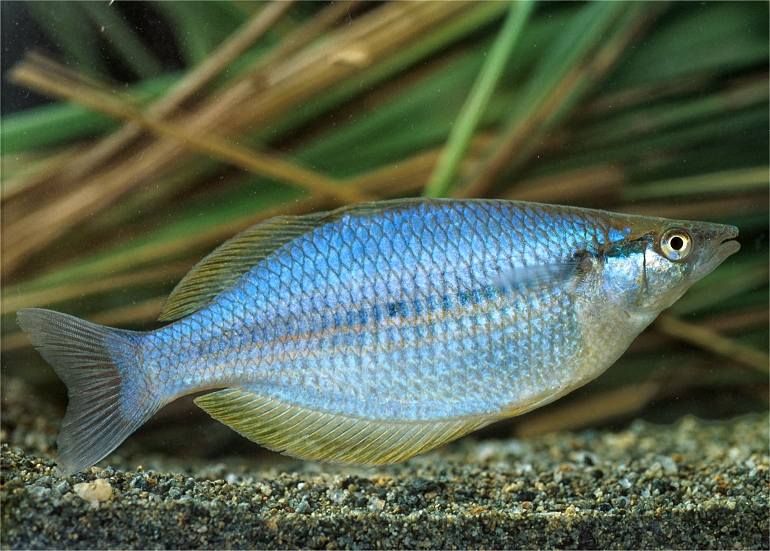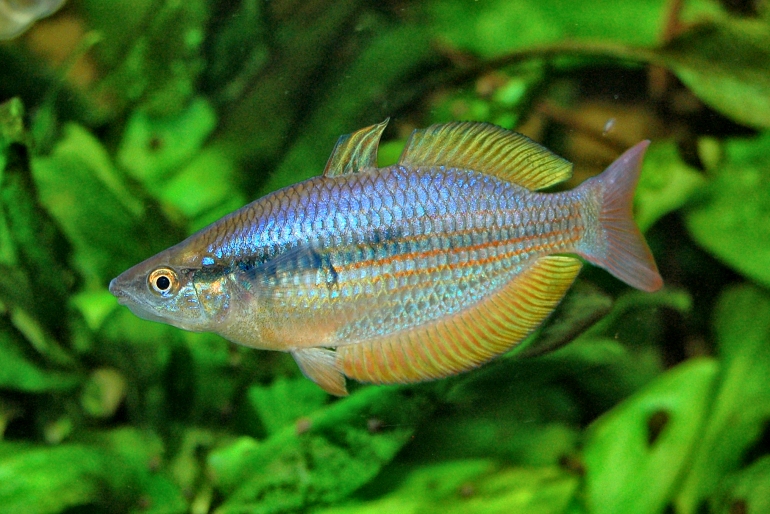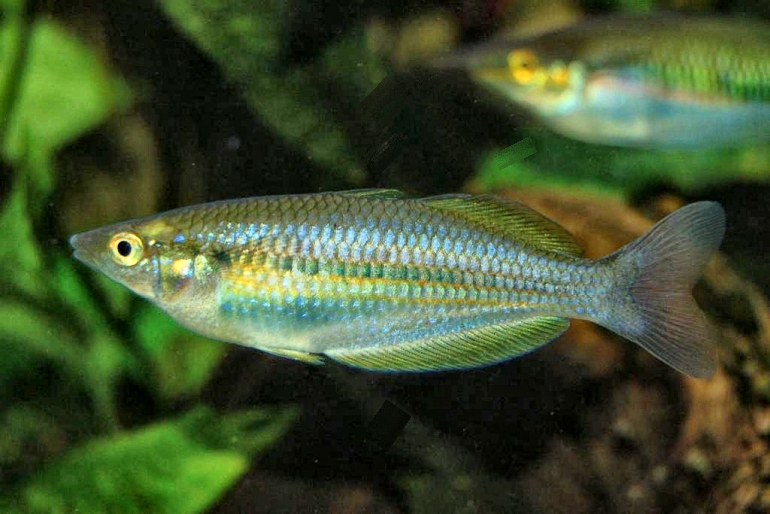|
 |
Chilatherina lorentzii [Sermowai River] - photo© Gerald Allen |
(Weber, 1908)
Lorentz's Rainbowfish
Species Summary
Chilatherina lorentzii have a basic bluish body colour grading to silvery-blue ventrally and a broad darker blue midlateral band, with clear to yellowish fins. They may attain a length of about 12 cm with a body depth of around 3-4 cm. Females are brownish-green on the upper body and silvery-white on lower half with a diffuse bluish mid-lateral band that extends from the eye to the middle of caudal fin base. The dorsal, caudal and anal fins are darkly-faded with the anal fin having a pale yellowish colour. The pelvic and pectoral fins are translucent.
Munro (1964) considered C. fasciata to be a junior synonym of C. lorentzii, but comparison of the respective types at the Zoological Museum of Amsterdam by Gerald Allen revealed important differences between these species. Chilatherina fasciata is a much more slender fish; males seldom exceed a maximum depth of 35% of the SL compared with frequent values exceeding this figure and sometimes over 40% in C. lorentzii. The caudal peduncle depth also reflects this difference with most specimens of C. fasciata under 11.3% whereas the values in C. lorentzii ranged from 11.3-13.6% SL. Counts for the anal rays and preopercle-suborbital scales are also useful for separating these species, although there is some overlap in the ranges. Additionally, the upper jaw of C. lorentzii is longer and reaches the level of the anterior edge of the eye, whereas that of C. fasciata fails to reach eye level.
Genetic evidence suggests this species should be placed in the genus Melanotaenia rather than Chilatherina.
 |
Chilatherina lorentzii [Sokoata River] - photo© Christophe Mailliet |
Distribution & Habitat
Chilatherina lorentzii have been collected in the Sermowai, Tawarin and Mamberamo rivers in northern West Papua, and from Puive Creek, a tributary of the Pual River, near Vanimo, Papua New Guinea. They were collected from a moderately-flowing stream that was enclosed by dense rainforest. The bottom was covered entirely with leaf litter. The fishes were confined in the deeper sections of the stream in the vicinity of waterplants and woody debris. Temperature 28° Celsius and pH 7.8.
In 2007, Chilatherina lorentzii were found in tributaries of the Gesa River System, Waropen Atas region in the north-western Mamberamo. Then in 2008, a survey by Conservation International and the Papuan State University (UNIPA) at Manokwari found Chilatherina lorentzii in tributary streams of the Tariku River (Rouffaer) near Haya Village. Three species of rainbowfishes were collected during these surveys which included Chilatherina fasciata, C. lorentzii and Glossolepis multisquamata. G. multisquamata was found in the lake-marsh habitats, C. fasciata was found in creeks near the village, and C. lorentzii were found in clear rocky streams about 6 km from the village.
 |
Chilatherina lorentzii [Sokoata River] (female) - photo© Christophe Mailliet |
Remarks
Live specimens were collected for the aquarium hobby by Gary Lange and Johannes Graf in 2012 from the Sokoata River, which is a tributary of the Sermowai River.
Literature
Allen G.R. (1991) Field guide to the freshwater fishes of New Guinea. Christensen Research Institute, Madang, Papua New Guinea.
Eschmeyer, W. N., R. Fricke, and R. van der Laan (eds). Catalog of Fishes: Genera, Species, References. Electronic version accessed 21 May 2016.
Weber M. (1907) Süsswasserfische von Neu-Guinea ein Beitrag zur Frage nach dem früheren Zusammenhang von Neu-Guinea und Australien. In: Nova Guinea. Résultats de l'expédition scientifique Néerlandaise à la Nouvelle-Guinée. Süsswasserfische Neu-Guinea 201-267.
Yoseph W. (2008) Pandangan dan Prinsip Pengelolaan Alam Masyarakat Adat Kampung Haya di Mamberamo. Conservation International Indonesia Papua Program 47 Halaman.
Adrian R. Tappin
Updated May, 2016



|

